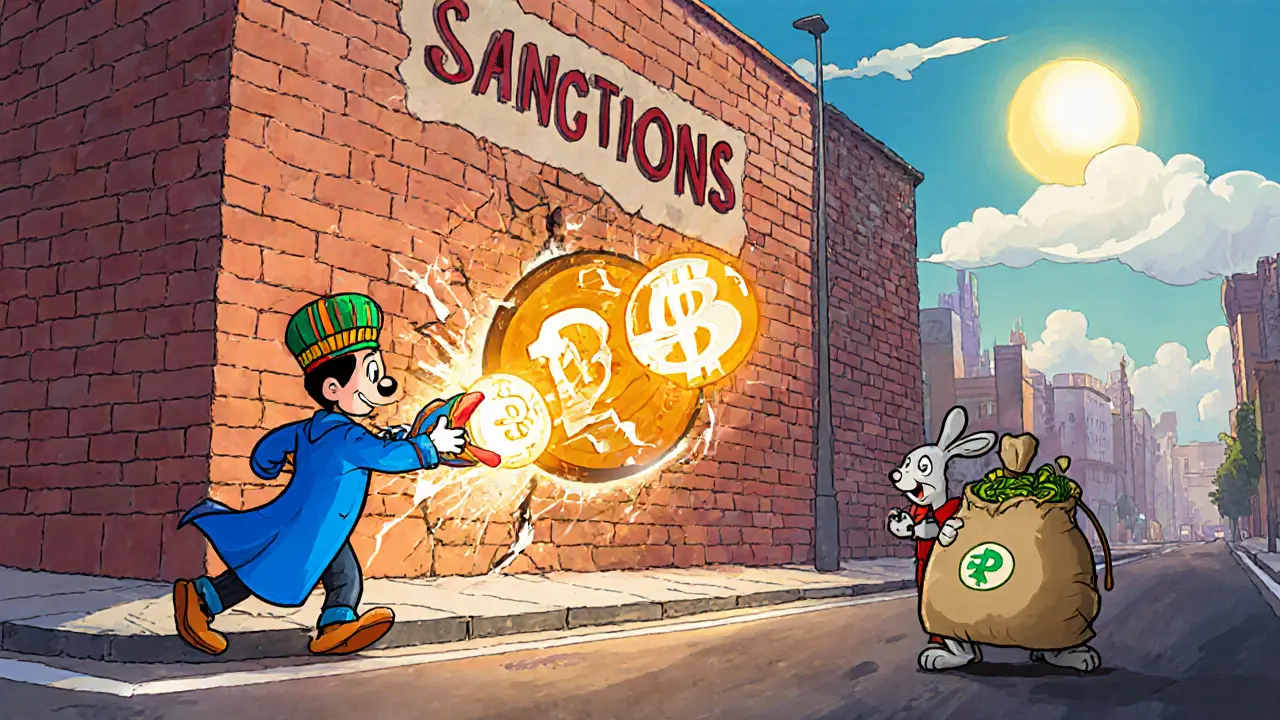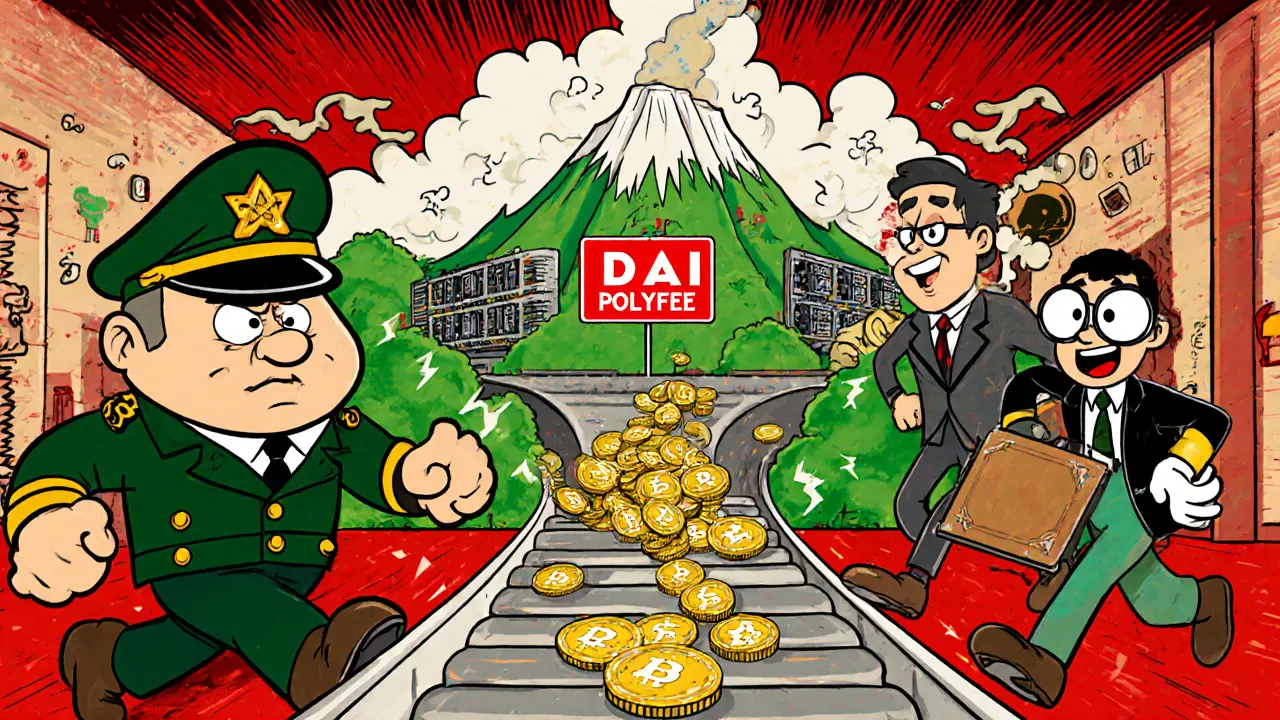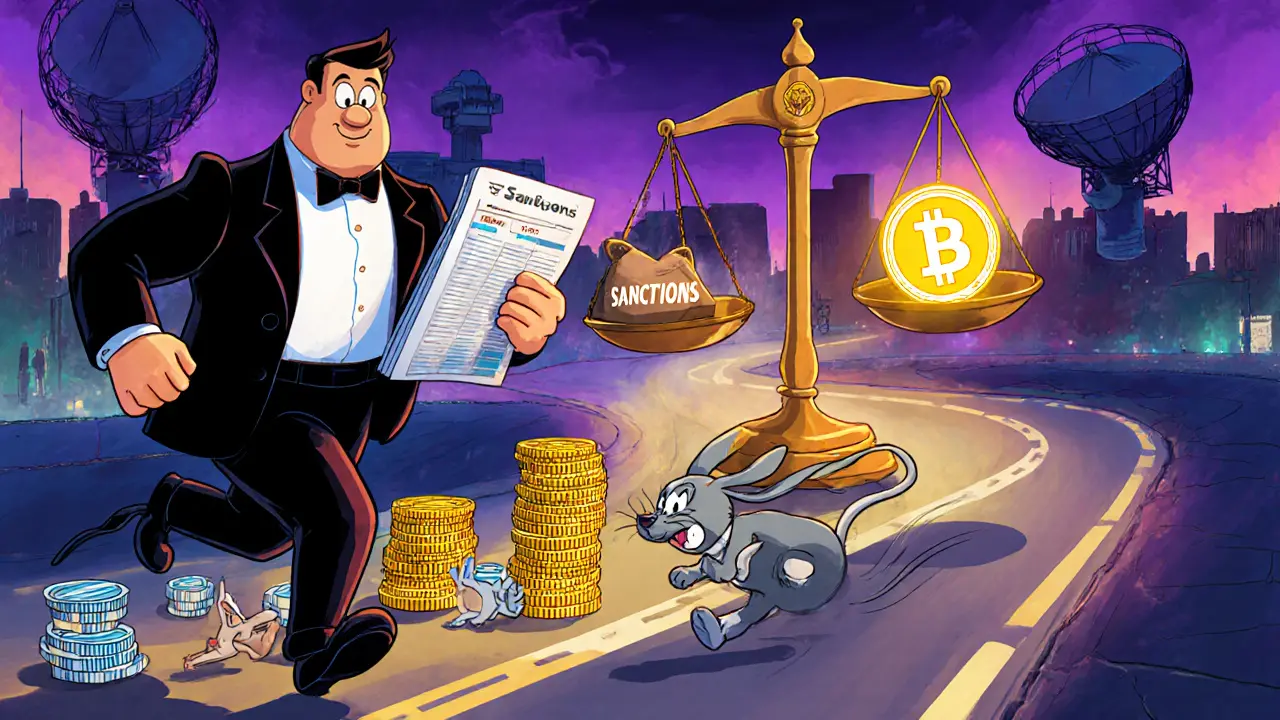
Iran Crypto Adoption Impact Estimator
Estimate Economic Resilience Through Crypto Adoption
This tool estimates how crypto adoption may contribute to economic resilience under sanctions by analyzing key factors such as daily transaction volume, stablecoin preference, and regulatory changes.
Estimated Impact Analysis
Enter values and click "Estimate Impact" to see analysis results.
TL;DR
- Sanctions forced Iran to build a home‑grown crypto ecosystem centered on domestic exchanges like Nobitex.
- The IRGC and Central Bank of Iran (CBI) now control most on‑ramp/off‑ramp points.
- Stablecoins (USDT, DAI) and the Polygon network are the preferred tools for evading freezes.
- Since 2024, enforcement actions have cut total crypto flows by ~11% but not demand.
- New tax law (Aug2025) signals Tehran’s intent to formalize and tax crypto activity.
Crypto adoption in Iran refers to the rapid uptake of digital assets among Iranian citizens, businesses, and sanctioned entities as a way to bypass international financial restrictions has become a textbook case of how a sanctioned state rewrites its financial playbook. When the United Nations and the U.S. Treasury slapped Iran with sweeping sanctions in 2017, traditional banking channels dried up, pushing traders, families, and even the Islamic Revolutionary Guard Corps (IRGC) toward a borderless alternative that could survive a blockade.
Why sanctions sparked a crypto boom
International sanctions act like a wall around a country's foreign‑exchange reserves. For Iran, the wall was built in 2017 and hardened each year thereafter. The International sanctions are legal measures that restrict a nation's access to global finance, trade, and assets eliminated most SWIFT connections, froze overseas assets, and prohibited most U.S. banks from dealing with Iranian counterparties. Faced with a shrinking ability to pay for imports or receive oil revenue, Iranians needed a way to move money without a correspondent bank.
The answer was digital: Bitcoin’s pseudonymous nature meant it could be sent over the internet without a bank, and stablecoins like USDT offered a dollar‑pegged store of value that could be swapped on‑chain. Within months, a network of wallets and local platforms sprouted, turning crypto into a de‑facto settlement layer for everything from oil payments to everyday remittances.
The key players: IRGC, CBI, and domestic exchanges
The Islamic Revolutionary Guard Corps (IRGC) is Iran’s elite military‑economic force that controls many strategic industries and sanctions‑evasion networks quickly recognized crypto’s strategic value. Treasury officials now describe digital assets as a “core settlement mechanism” for IRGC‑linked procurement. At the same time, the Central Bank of Iran (CBI) is the state agency that regulates money, foreign exchange, and now cryptocurrency transactions tried to keep a leash on the market by blocking anonymous web‑based conversions in December2024, only to reopen limited channels in January2025 through government‑controlled APIs that force users to share identity data.
Enter Nobitex Iran’s largest domestic crypto exchange, offering rial‑paired trading pairs and direct links to CBI APIs. By mid‑2025, Nobitex handled roughly 60% of all Iranian crypto volume, making it the linchpin for both legitimate traders and sanctioned networks. Its API‑driven model lets the CBI monitor transactions in real time, yet the platform still provides a veneer of anonymity for users who hide behind VPNs.
Mining, energy, and the underground shift
In 2019 Tehran legalized cryptocurrency mining as a revenue generator. The law required licensed miners to sell their output straight to the CBI at a state‑set price, and imposed steep electricity tariffs to curb runaway power use. While the policy succeeded in creating a visible mining sector, the high costs forced many operators underground. Unlicensed farms now run in hidden locations, often powered by subsidized electricity or even illegal grid connections. This bifurcated structure-legitimate, CBI‑controlled mining versus a shadow network-keeps the supply of Iranian‑mined coins flowing but makes the sector a frequent target for enforcement raids.

Stablecoins, transaction layering, and the “Polygon pivot”
Data from blockchain‑intelligence firms show a clear pattern: Iranian users first convert rial into USDT or TRX, then shuffle the tokens through multiple intermediary wallets to hide the trail. Once layered, the funds are off‑ramped via exchanges with weak Know‑Your‑Customer (KYC) controls. After the massive July2025 Tether freeze-42 addresses holding over half of the frozen USDT linked to Nobitex-users rapidly swapped USDT for DAI a decentralized, dollar‑pegged stablecoin on the Ethereum ecosystem and moved the assets onto the Polygon network a layer‑2 scaling solution for Ethereum that offers low fees and fast confirmations. The shift was driven by two factors: Polygon’s sub‑$0.01 transaction cost compared with Ethereum’s $10‑$20 fees, and the network’s reputation for being less scrutinized by U.S. enforcement agencies.
Enforcement pressure and the 2025 flow dip
From January to July 2025, Iranian crypto flows totaled about $3.7billion-an 11% drop from the same period in 2024. The decline is not a sign of waning demand; rather, it reflects the tightening grip of the Office of Foreign Assets Control (OFAC) and allied agencies. In 2024, OFAC issued 13 designations that included wallet addresses, a record for the past seven years. The July2025 Tether freeze, combined with a wave of designations targeting oil‑related entities in August2025, forced domestic exchanges to diversify settlement methods and spurred a flood of guides on Telegram and Reddit for cross‑chain swaps.
Despite the pressure, the crypto ecosystem proved resilient. Users continued to employ VPNs to reach foreign platforms, and many shifted to DAI/Polygon to stay one step ahead. The cat‑and‑mouse dynamic illustrates a broader truth: when conventional finance is blocked, digital assets become a survival tool rather than a speculative luxury.
Regulatory tightening: tax law and the future
In August2025 Tehran passed the Law on Taxation of Speculation and Profiteering, levying capital‑gains tax on crypto trades for the first time. The legislation places crypto alongside gold, real estate, and forex, signaling a shift from outright prohibition to regulated acceptance. The law’s phased rollout-initially applying only to transactions above 5billion rials-shows the government’s desire to avoid a market shock while still extracting revenue.
Looking ahead, two forces will shape crypto adoption in Iran: the intensity of international sanctions enforcement and the domestic political calculus of maintaining economic stability. If sanctions tighten further, we can expect deeper migration to privacy‑oriented solutions (e.g., Zcash, Monero) and more sophisticated layering. Conversely, if Tehran relaxes API restrictions, the state could gain richer data on citizen flows, potentially using that intelligence to target illicit actors while still allowing the broader public to benefit from digital finance.
Quick reference guide
| Entity | Primary Role | Regulatory Status (2025) |
|---|---|---|
| Nobitex | Domestic exchange, primary on‑ramp/off‑ramp | Licensed, API‑linked to CBI, KYC mandatory |
| IRGC | Strategic patron of crypto‑based procurement | Sanctioned, operates via covert wallets |
| Central Bank of Iran (CBI) | Regulator, monitors API traffic, controls mining sales | Enforced crypto‑to‑rial block, partial reversal 2025 |
| Tether (USDT) | Stablecoin used for dollar‑pegged transfers | Subject to large freezes (July2025) |
| DAI (Polygon) | De‑centralized stablecoin on low‑fee network | Preferred post‑freeze alternative |
Next steps for users, businesses, and policymakers
For individual users: Keep a secure hardware wallet, stay updated on which wallets are flagged by OFAC, and consider cross‑chain swaps to Polygon when USDT freezes occur.
For Iranian businesses: Integrate CBI‑approved API endpoints for compliance, and diversify settlement between USDT, DAI, and local rial‑pegged tokens to reduce single‑point risk.
For international regulators: Continue targeting wallet addresses, not just entities, and share real‑time alerts with exchanges that have weak KYC to disrupt layering.
For scholars and analysts: Monitor the evolving tax regime and the volume of crypto‑to‑rials reported by the CBI; these metrics will indicate whether Tehran is moving toward greater openness or tightening control.

Frequently Asked Questions
Why does Iran rely heavily on crypto despite the risks?
Sanctions cut off traditional banking, so crypto provides a way to move money across borders, preserve value, and pay for imports without a SWIFT connection. The freedom to store assets with just a seed phrase outweighs the fear of occasional freezes.
What role does the IRGC play in the crypto market?
The IRGC uses crypto to fund procurement networks, evade sanctions, and funnel oil revenues. Its wallets are often linked to domestic exchanges, making it a central node in the transaction graph.
How did the July2025 Tether freeze affect Iranian users?
The freeze locked more than half a billion dollars in USDT, prompting a rapid migration to DAI on Polygon. Users exchanged USDT for DAI via decentralized bridges and shifted to the lower‑fee Polygon network to keep funds liquid.
Is crypto mining still profitable in Iran?
Licensed mining faces high electricity tariffs that make it marginally profitable. Many miners have gone underground, using subsidized power or illicit grids to stay viable, but the sector is fragmented and risky.
What does the new tax law mean for everyday traders?
Trades above 5billion rials now incur a capital‑gains tax. The law aims to formalize crypto as a taxable asset while avoiding a sudden market crash by phasing in gradually.

Stefano Benny
February 4, 2025 AT 17:22🚀 The crypto surge in Iran is just another hype bubble masked as “sanctions resilience,” and the metrics they cherry‑pick-daily volume spikes, stablecoin swaps-are classic noise. 🤔📈 When you strip away the jargon, you see a fragile patchwork of VPNs and ad‑hoc bridges that can crumble under a single OFAC designation. 🛑
Sophie Sturdevant
February 5, 2025 AT 15:35Listen, the data points aren’t “noise”-they’re proof that users are adapting under pressure. The IRGC’s integration of Nobitex APIs shows an institutional backbone, and the shift to Polygon underscores a strategic cost‑optimization, not a fleeting meme. Double‑down on those layers; they’re the future of resilient finance.
Nathan Blades
February 6, 2025 AT 13:48What’s fascinating is the philosophical paradox: a regime that once banned private finance now leans on decentralized protocols to survive. It’s a live case study in how scarcity fuels innovation, turning every transaction into a micro‑rebellion against external constraints. The ecosystem’s resilience is both technical and existential.
Somesh Nikam
February 7, 2025 AT 12:02Absolutely, and the human side shines through-people are juggling daily needs with crypto tools, often after long workdays. 😊 The optimism I see on Telegram groups reflects a collective hope that these digital bridges will keep families fed and businesses afloat.
MARLIN RIVERA
February 8, 2025 AT 10:15The whole “crypto salvation” narrative is a convenient excuse for incompetence. Iran’s government can't manage its own currency, so it leans on a speculative market that everyone knows is volatile. Stop romanticizing a system that’s built on anonymity and illegal activity.
Debby Haime
February 9, 2025 AT 08:28While the risks are real, dismissing the entire ecosystem ignores the lived reality of millions who depend on these tools for basic transactions. The new tax framework, however harsh, signals a move toward legitimacy that could stabilize the market.
emmanuel omari
February 10, 2025 AT 06:42From a national standpoint, Iran’s crypto strategy is a sovereign response to unjust external pressure. By harnessing decentralized finance, the nation safeguards its economic sovereignty and reduces dependency on hostile financial institutions.
Andy Cox
February 11, 2025 AT 04:55True, the cultural shift is noticeable. Locals are more tech‑savvy now, and the casual mention of “swap on Polygon” in everyday conversation shows how normalized this tech has become.
Courtney Winq-Microblading
February 12, 2025 AT 03:08The dance between state control and decentralized liberty in Iran reads like a modern fable. Each layer of smart contracts and off‑ramp bridges adds a stanza to a poem about resilience, where the verses are written in code and the chorus is the collective will to persevere.
katie littlewood
February 13, 2025 AT 01:22First, the sheer scale of daily transaction volume-over $100 million in some months-signals that crypto is no longer a fringe hobby but a mainstream utility for ordinary Iranians. Second, the dominance of USDT before the July freeze illustrates how users gravitated toward the most liquid, dollar‑pegged asset available, despite its centralized nature. Third, the rapid pivot to DAI on the Polygon network demonstrates a community that can collectively rewire its financial infrastructure in real time, a feat few economies can boast. Fourth, the involvement of the IRGC adds a layer of strategic depth, turning crypto into a state‑sanctioned tool for procurement and sanctions evasion. Fifth, the Central Bank’s partial reversal of its crypto‑to‑rial block in early 2025 reflects an uneasy balance between control and necessity, acknowledging that outright bans would cripple essential commerce. Sixth, the underground mining sector, thriving on subsidized electricity, shows how the state’s policies inadvertently nurture a shadow industry that fuels the ecosystem. Seventh, the fact that enforcement actions only reduced flow by 11 % underscores the market’s elasticity and the ingenuity of its participants. Eighth, the emerging tax regime, targeting trades above 5 billion rials, indicates a move toward fiscal integration without stifling growth. Ninth, the use of VPNs and encrypted messaging for cross‑border swaps highlights a cultural adaptation to digital security norms. Tenth, the educational content proliferating on Telegram and Reddit equips newcomers with the technical know‑how to navigate complex bridges and layer‑2 solutions. Eleventh, the ongoing dialogue between regulators and exchanges like Nobitex fosters a feedback loop that could eventually standardize compliance without sacrificing privacy. Twelfth, the presence of decentralized finance (DeFi) protocols on Polygon offers lower fees, making micro‑transactions viable for everyday purchases. Thirteenth, the interoperability between stablecoins and native tokens creates a hedging mechanism against volatile market swings. Fourteenth, the geopolitical dimension-where each freeze or sanction prompts a technical countermeasure-makes Iran’s crypto landscape a live laboratory for economic warfare. Finally, the human element-families using crypto to send remittances, merchants accepting it for goods-cements its role as a lifeline, not just an investment vehicle, ensuring its persistence well beyond any regulatory crackdown.
Jenae Lawler
February 13, 2025 AT 23:35It is intellectually dishonest to portray Iranian crypto adoption as a “miracle of liberty” when, in fact, it is a coerced adaptation to systemic isolation, funded by state actors who manipulate markets for their own geopolitical agendas.
Chad Fraser
February 14, 2025 AT 21:48Let’s keep the focus on solutions: diversifying stablecoins, improving user education, and fostering transparent APIs can empower ordinary users while limiting state overreach.
Jayne McCann
February 15, 2025 AT 20:02People think crypto is a panacea for sanctions, but it’s just another set of tools the government can control.
Richard Herman
February 16, 2025 AT 18:15I hear you, but the reality is nuanced; while there is government involvement, the decentralized nature still provides a degree of autonomy that many find valuable.
Parker Dixon
February 17, 2025 AT 16:28Exactly! 🌟 The hybrid model-state‑approved APIs paired with open‑source bridges-creates a resilient ecosystem that can adapt to policy shifts while preserving user agency. 😊
Bobby Ferew
February 18, 2025 AT 14:42It’s exhausting watching the same old “crypto will save us” mantra get recycled, especially when the underlying volatility never gets the respect it deserves.
celester Johnson
February 19, 2025 AT 12:55One must question the sincerity behind such proclamations; they often serve as distraction from deeper socioeconomic failures that no token can rectify.
Prince Chaudhary
February 20, 2025 AT 11:08Stay resilient and keep learning.